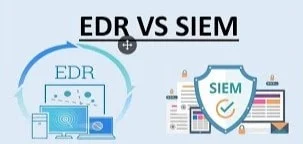According to Aag IT, more than 236 million ransomware attacks were reported in the first half of 2022. More than 620 millions attackes were reported worldwide in 2021.Ransomware attacks are 20 percent of all cybercrime attacks.
If an organization wants to deal with ransomware, utilizing some cybersecurity solutions is vital. Two standard solutions are SIEM and EDR. Before investing in any solution, you should understand what they are and how they benefit your enterprise. Later on, all you need to do is to compare them and pick the right one for your organization. Let's continue reading and uncover all these details.
What is the Difference between SIEM and EDR?
Before you know the main differences between both security solutions, it is essential to understand both terms.
What is EDR?
It stands for Endpoint Detection and Response system designed to detect, prevent, and respond to cyber threats. This solution monitors all the endpoints and records all the activities and behavioral data.

How EDR Works?
As soon as it identifies any malicious activity across the endpoint, it isolates the endpoint and contains the threat while sending an alert to the system administrator. A security admin analyzes this threat and responds accordingly.
The main capabilities of this tool are incident response, alert triage, data enrichment, threat-hunting support, and flexible response.
What is SIEM?
It stands for Security Information and Event Management. It collects data from different corporate resources and then stores it on a single dashboard- where security analysts can use it for further threat investigation and analysis. It also provides prioritized security alerts, so your security team knows what incident to investigate first.
How Does SIEM Works?
This cybersecurity solution helps your team identify and investigate threats across all organization networks by following these four steps.
Data Collection
This software gathers all the data, log info and alert from endpoints, servers, cloud stations, and other IT infrastructure points.Data Aggregation and Normalization.
In this second step, this software translates all the data collected into a consistent form so that when team members try to compare this or insight, they don't need to deal with different types and formats.
Analytics and Policy Application
This tool is integrated with statistical analysis tools and advanced analytics that let this software identify potential indicators of an attack. Since it also has pre-set corporate policies, this software analyzes activities to ensure that it complies with corporate security policies.
Security Alert
In this step, SIEM relies on a ticket system or bug trackers to streamline incident response. Once all the information is aggregated, it is sent to your security analysts so they can identify threats by digging deep into all these logs. This data aggregator helps them in forensic and efficient threat response.
What is the difference between SIEM and EDR?
Regarding advanced enterprise security solutions, both SIEM and EDR are helpful for your organization. It empowers your security team with excellent visibility into endpoints, cloud stations, servers, and other areas. They both collect data and present a complete report to an analyst. They generate alerts so your security team can readily evaluate an incident and perform active threat hunting. Although they are similar in many ways, there is some key difference between both security tools. Let's continue reading and find them out.
Threat Surface
EDR offers security coverage across all the endpoints. However, SIEM tools are broader in threat surface. It means that these tools provide visibility into the entire IT infrastructure, not just in endpoints.
Response Functionality
Another point that sets them both apart is response capability. EDR helps in threat detection and response. It has predefined actions that it takes in case of specific threats. On the other hand, SIEM is a data aggregator and analyzer. It has limited response functionality.
Data Source
An Endpoint Detection and Response solution collects and monitors all the data of endpoints. However, SIEM doesn't rely on an endpoint only. It contains and aggregates data from all the different sources.
What is the Difference between SIEM and EDR? And Which One Do You Need?
You have got a clear idea of the main differences between both options. Now the question is what you need. The fact is that your organization requires both SIEM and EDR. When protecting endpoints against sophisticated threats, you should always rely on EDR because this security solution offers your cybersecurity team real-time monitoring and threat visibility. It empowers them with the tools required to perform efficient threat hunting. Regarding SIEM, it would help if you had it to secure all the threat surfaces. Protecting endpoint alone won't do any good unless you have comprehensive tools that collect and correlates data from all available sources. Getting SIEM means having complete IT infrastructure insight to define threat scope and make a critical decision.